Mark your calendars. Larch viewing season in Alberta is coming in September and you’re going to want to catch it. If you’ve seen the larches in their full autumn glory you know what I’m talking about. If you haven’t, you’re missing one of the best displays Mother Nature offers us in Alberta. It’s akin to the magnificent fall foliage display people living in the east enjoy. There aren’t many great larch sightings you can experience from the car, so plan on as many larch hikes in Alberta as you can fit in your calendar.
Described below are some of the best larch hikes in Alberta and where you’ll find them. Remember the window to catch them at their peak is narrow, so book time off so you can experience Mother Nature in all her glory.
This post includes some affiliate links. If you make a purchase via one of these links, I will receive a small commission at no extra cost to you. Thank you very much for your support.
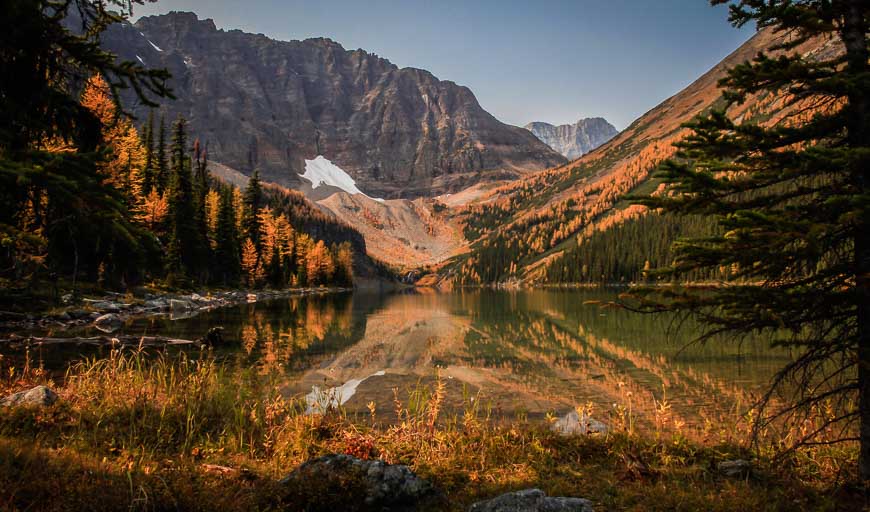
When is peak season for larch hikes in Alberta?
Unlike the Foliage Network in the United States and the day to day cherry blossom forecasts available in Japan, Alberta has no real-time larch hotline; but historically the peak time for larch hikes in Alberta and viewing has been around the third and fourth week in September.
What is a larch?
Larches are coniferous trees that lose their needles every fall. Before the needles drop they turn from green to a spectacular golden yellow. In Alberta, the trees we see are alpine larches (Larix lyalli). Because they usually grow in stands at high elevations, the impact of their foliage display is nothing short of stunning.
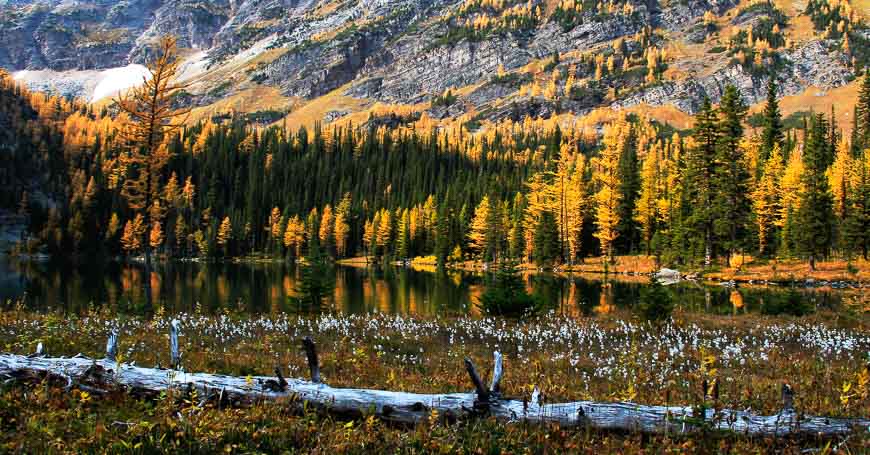
Larch hikes in Alberta near Lake Louise
Larch Valley hike for a premiere experience
Distance: 11.6 km return to Sentinel Pass but 7.0 km return gets you to Larch Valley
Time needed: 2.5 – 5 hours depending on how far you hike
The Larch Valley hike near Lake Louise is the premiere destination for larch viewing in Alberta. But it comes with crowds and because you can no longer drive Moraine Lake Road (as of 2023), you’ll have to book a shuttle.
Imagine Chinook Mall in Calgary at its busiest. You get the idea. If you’re still keen to see what all the fuss is about, book a shuttle to Moraine Lake with Parks Canada or privately via the Moraine Lake Bus Company.
It’s 3.5 km one way to the start of Larch Valley, so no matter what you’ll need to plan on a 7.0 km return hike. Once you’ve hiked up to Larch Valley, you won’t find there is much elevation gain until you head for Sentinel Pass. You could spend hours on a sunny day, wondering around in awe of the beauty. I think it’s worth a visit – and you’ll be able to visit Moraine Lake too.
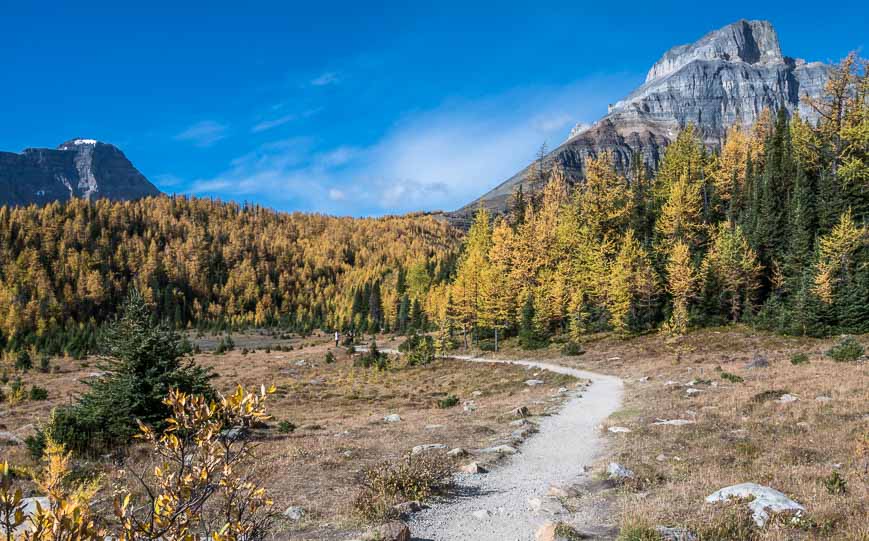
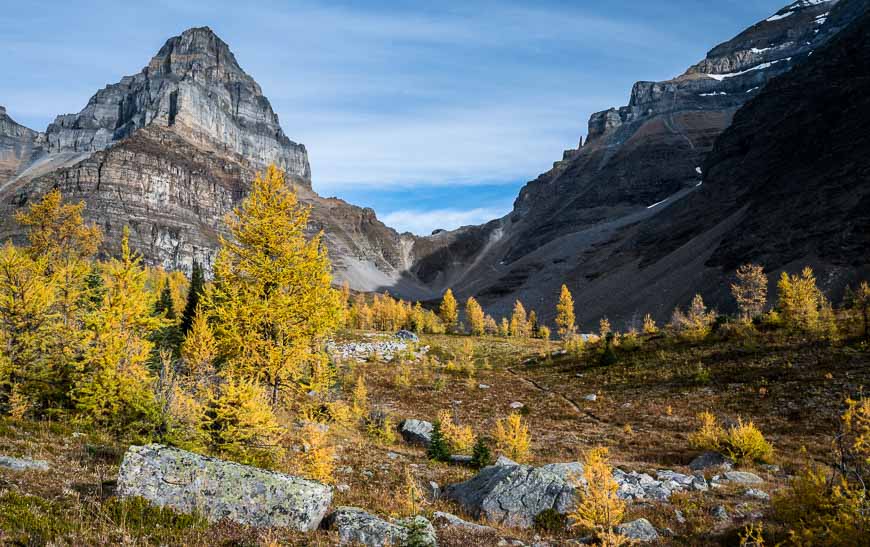
Saddleback and Fairview Mountain hike
Near Lake Louise, there are a couple of standout hikes as well. If you hike to the Saddleback (7.4 km and 3 – 4 hours return) or the summit of Fairview Mountain (10.6 km return and 5 – 6 hours), you’ll pass through some beautiful stands of larch and the view from the top will be filled with golds and yellows.
Lake Agnes – Big Beehive hike
A less onerous hike would be to the top of Big Beehive (10 km return and 3-4 hours) via the Lake Agnes Tea House. Again the crowds will likely be extreme – but so will the scenery. Take the shuttle unless you arrive at the Lake Louise parking lot early in the morning.
Taylor and O’Brien Lakes – for one of the best larch hikes in Alberta
Distance: 13 km return to Taylor Lake plus 3.6 km return to O’Brien Lake (and you don’t want to miss this gem)
Elevation gain: 595 m or 1,952 feet to Taylor Lake and approximately 75 m or 246 feet more to reach O’Brien Lake.
Taylor and O’Brien Lakes offer exceptional larch viewing without the crowds. Accessed via the Taylor Lake Trailhead on the Trans-Canada Highway west of Banff, the Taylor Lake hike will take the better part of a day. This hike is getting busier but the crowds are a fraction of what you’d find on most other hikes as it requires some effort.
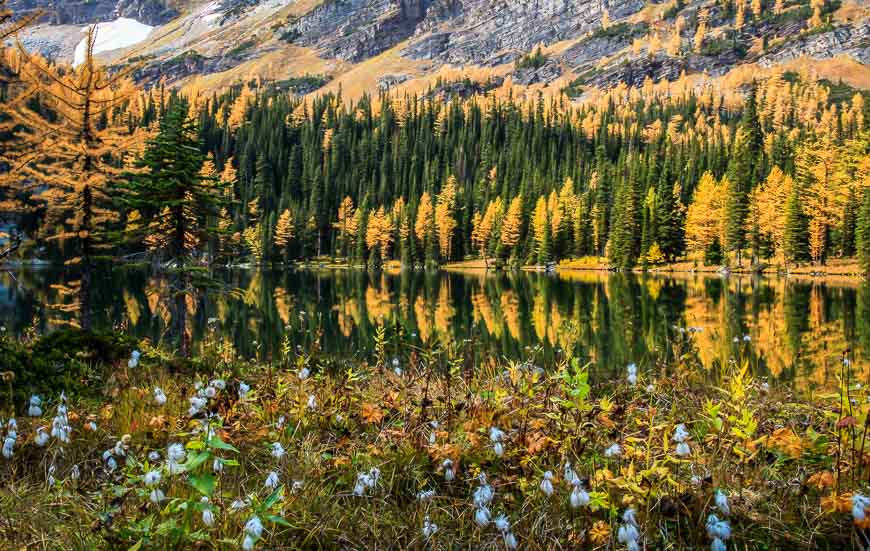
Rockbound Lake as a larch hike
Rockbound Lake (16.8 km/5 – 6 hours) is accessed via the trailhead just east of Castle Village. It’s another hike without people. Once you’ve dispatched with the section of trail on an old road, you’ll be rewarded with meadows dotted with larch trees. From here through to the lake they will offer bursts of colour.
Boulder Pass hike near Lake Louise
Distance: 17 km return or 10.6 miles
Elevation gain: 645 m or 2,116 feet
Time needed: 6 – 8 hours
Boulder Pass is climbed on route to Skoki Lodge. Accessed via a trailhead just minutes from the Lake Louise Ski Resort, the length is such that you won’t have to share the trail with many people. The larches are best the higher you go on the trail and the scenery around Boulder Pass and Ptarmigan Lake is outstanding.
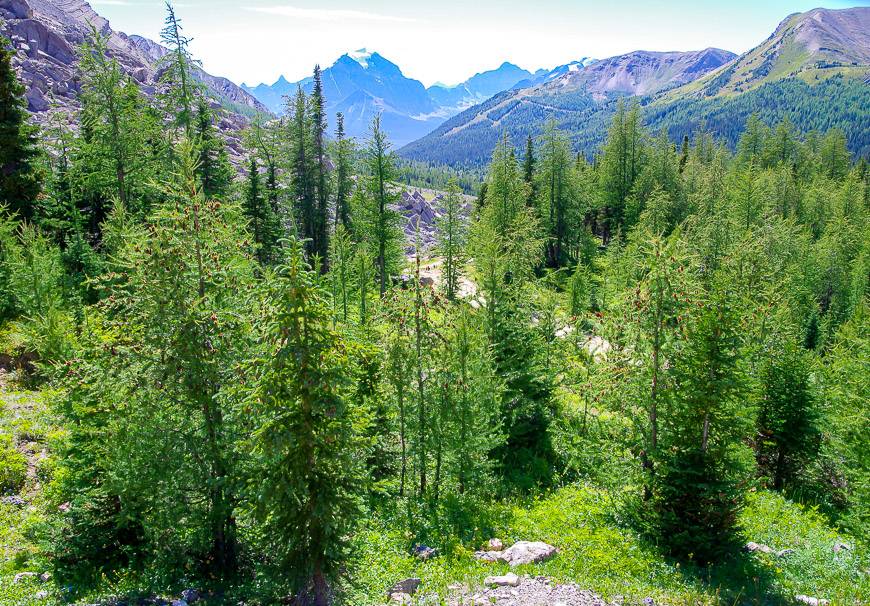
Larch hikes in Alberta close to Banff
Healey Pass near Sunshine Village
Distance: 18.4 km return or 11.4 miles
Elevation gain: 655 m or 2,150 feet from the Sunshine parking lot. It’s 360 m or 1,180 feet from Sunshine Village to Healey Pass.
Time needed: 6 – 7 hours
Healey Pass offers fantastic views no matter what the season. Unfortunately the gondola from Sunshine Village doesn’t usually operate during larch season, sp be prepared to hike the whole way. Revel in the views – which include small lakes interspersed with massive stands of larches.
This is one of the standout larch hikes in Alberta, but it does require a lot of effort.
This post that takes in Healey Pass with summer pictures will give you an idea of the beauty of the area.
Arnica Lake, Twin Lakes and Gibbon Pass hike
Count on a full day to take in the Arnica Lake hike (10.0 km return and 3 -4 hours), Twin Lakes (15.8 km return and 5 -7 hours) and Gibbon Pass (21.6 km return and 8 – 10 hours) unless you come in from Shadow Lake Lodge in which case it’s only 6.2 km return to Gibbon Pass.
Start at either the Vista Lakes Trailhead on Highway 93 or the Twin Lakes Trailhead just west of the Trans-Canada on Highway 93. In larch season, I would highly recommend getting to the trailhead early as the cars end up spilling onto the highway for up to a kilometre! There are great stands of larches in a magnificent mountain setting offering sumptuous views. This is one of the premiere larch hikes in Alberta but you have to work for them.
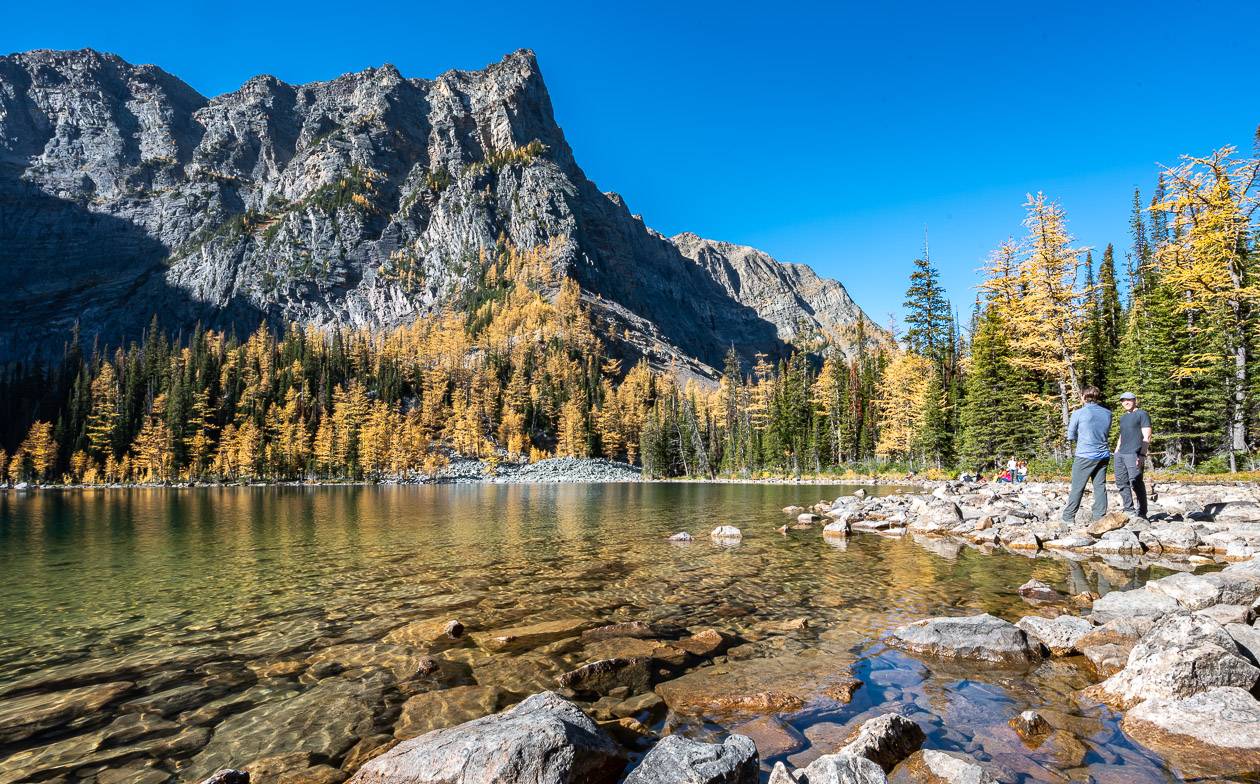
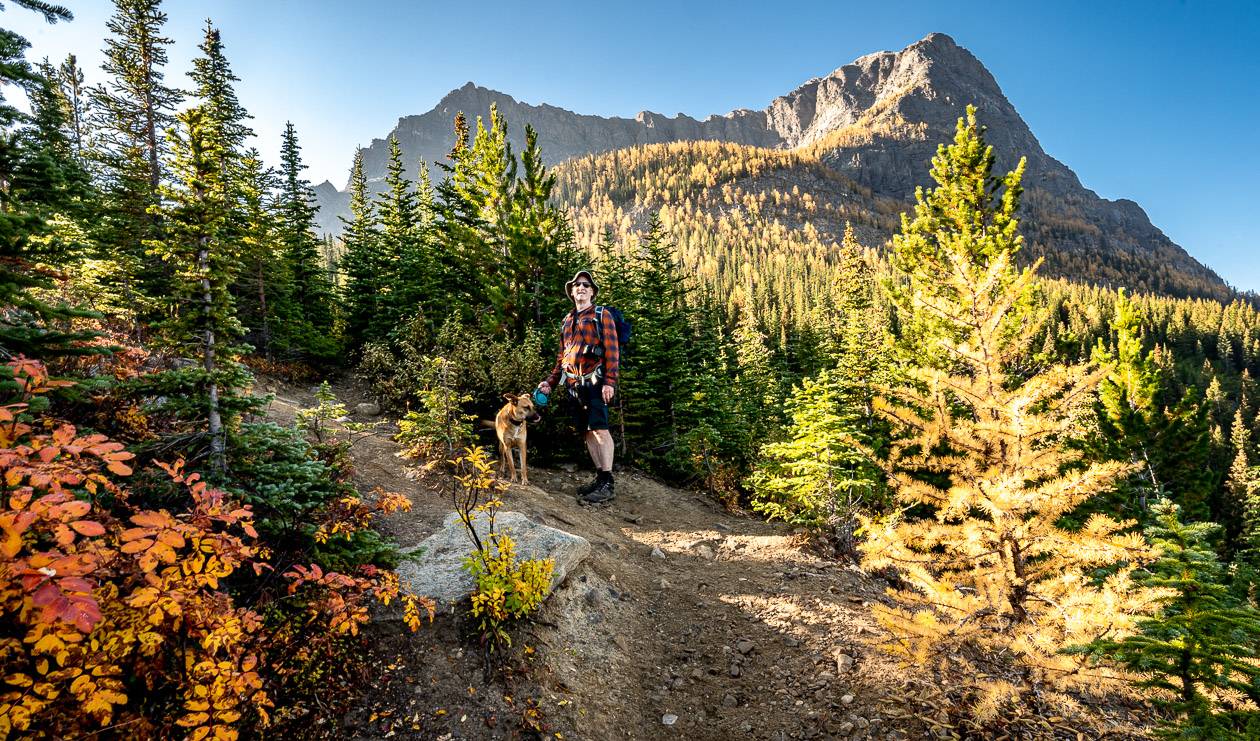
Larch hikes in Alberta in Kananaskis Country
You must purchase a Kananaskis Conservation Pass – either as a day pass or a yearly pass to do any of the larch hikes in Alberta’s Kananaskis Country.
Pocaterra Ridge – one of the top larch hikes in Alberta
In speaking with locals, Pocaterra Ridge is the hike that comes up as their number one choice for a larch hike in Kananaskis Country. It’s best done as a car shuttle with a start at the Highwood Pass parking lot.
Walk 11 km along the ridge (over the better part of 6 – 7 hours) and enjoy some of the best views in Kananaskis Country. Throw in great swaths of larches and you have a total winner of a fall hike. Finish at the Little Highwood Pass parking lot. Note that between Peaks 2 and 3 along the ridge, there is an especially dense larch forest.
As well, there are magnificent expansive views of larch trees in the valley below.
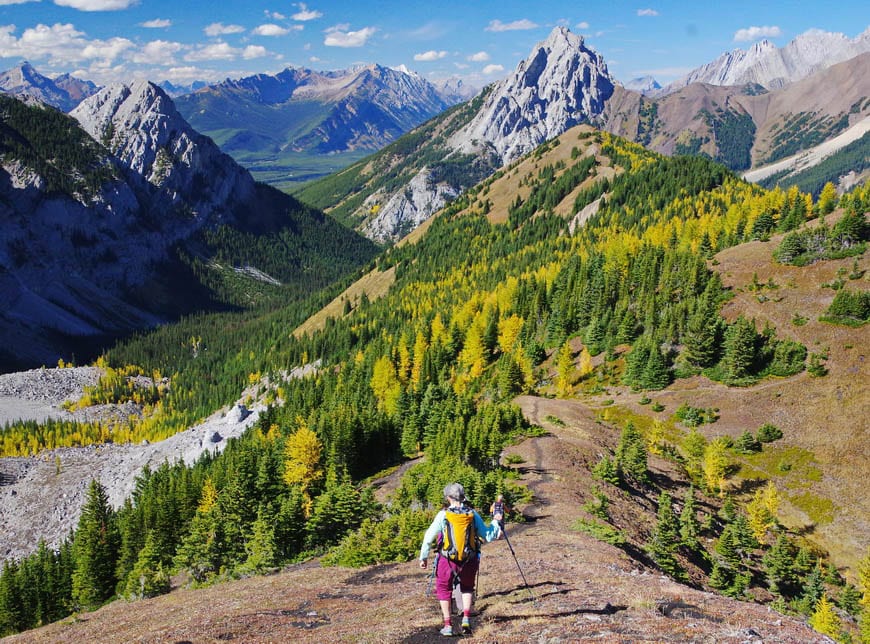
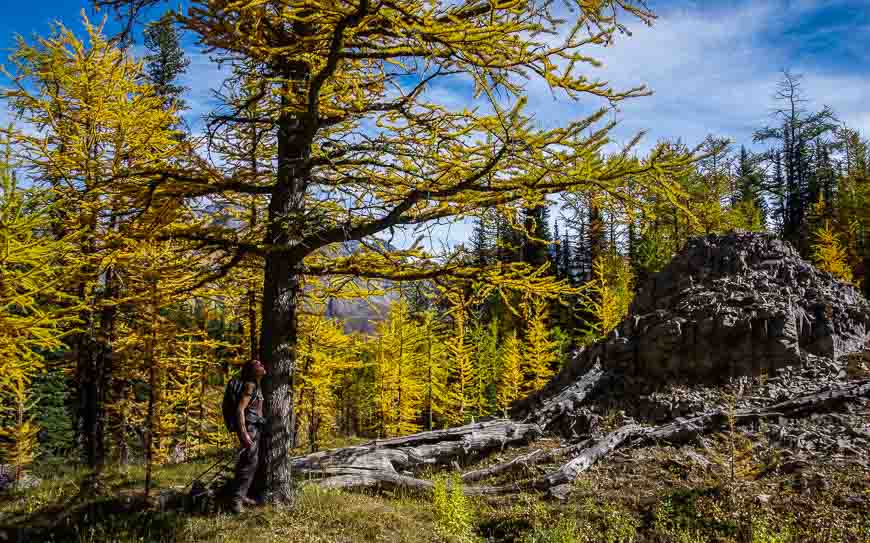
Ptarmigan Cirque – one of the easier larch hikes in Alberta
For a shorter, easier option with easy access, hike up Ptarmigan Cirque (4.5 km return with 214 m elevation gain/2 -3 hours) for excellent views 0f larches. This one is a good family-friendly hike though it is steep for the first 20 minutes.
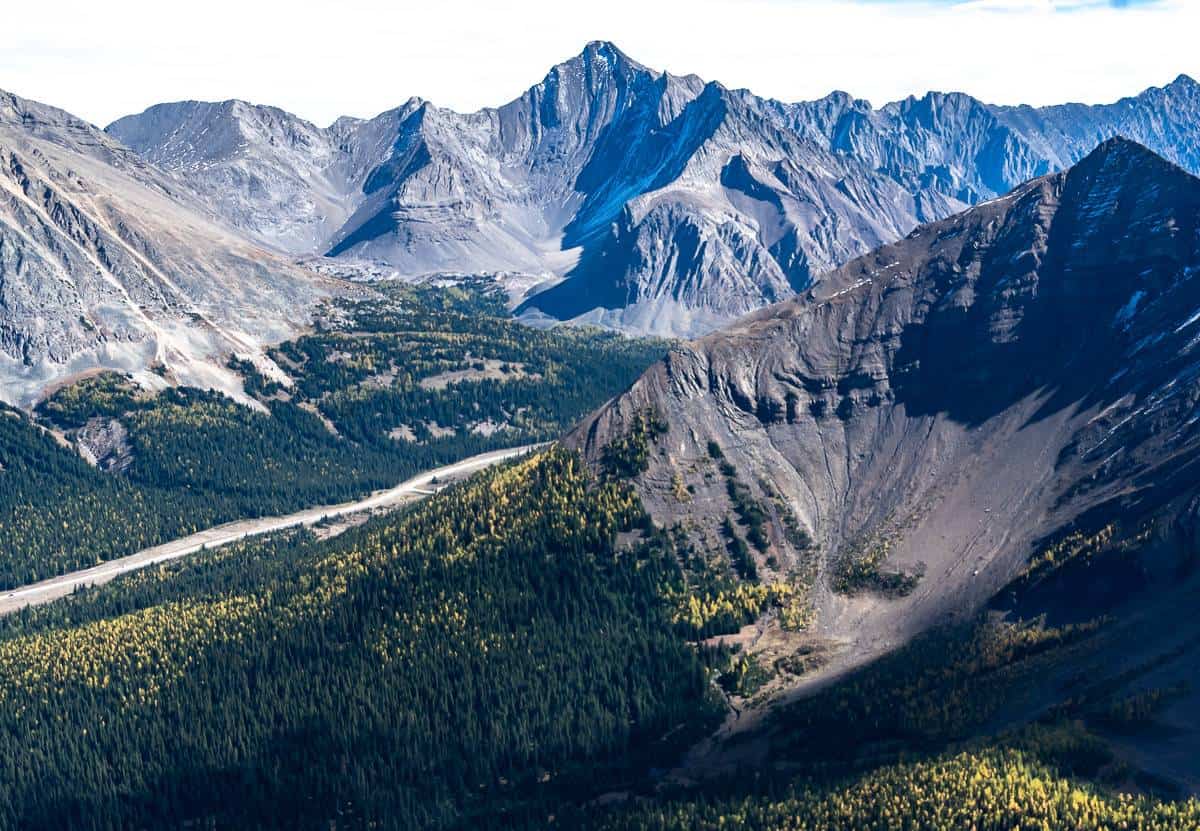
Chester Lake, Kananaskis Country
Distance: 9.8 km round trip or 6.1 miles
Elevation gain: 315 m or 1,033 feet
Time needed: 3 – 4 hours
Chester Lake is a multi-season destination that always shines. The lake is located in Spray Valley Provincial Park, about 43 km from Canmore via the Spray Lakes Road. This is one of the quintessential larch hikes in Alberta. but expect to see lots of people on a sunny weekend. It’s also a family-friendly hike if your kids are about 8 or older.
Chester Lake is the prize on this hike, surrounded by larches and the cliffs of Mt. Chester.
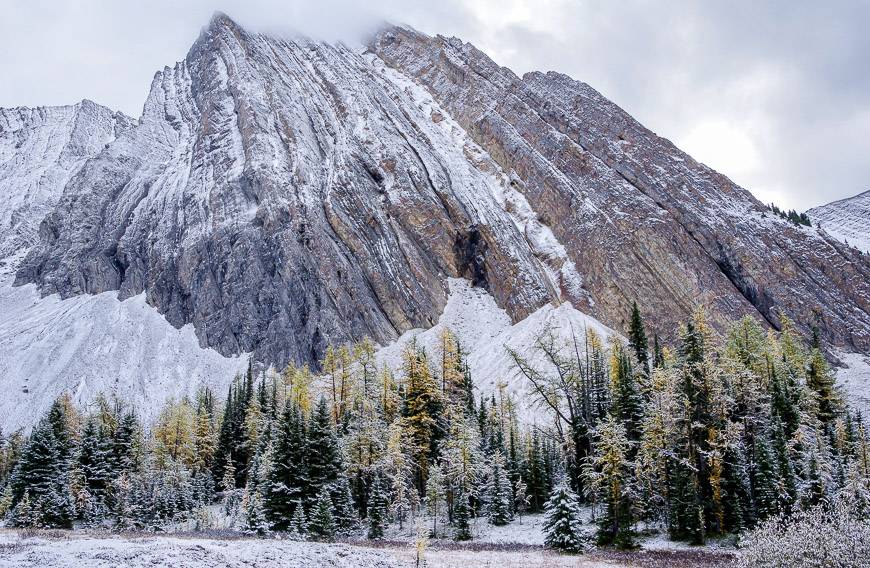
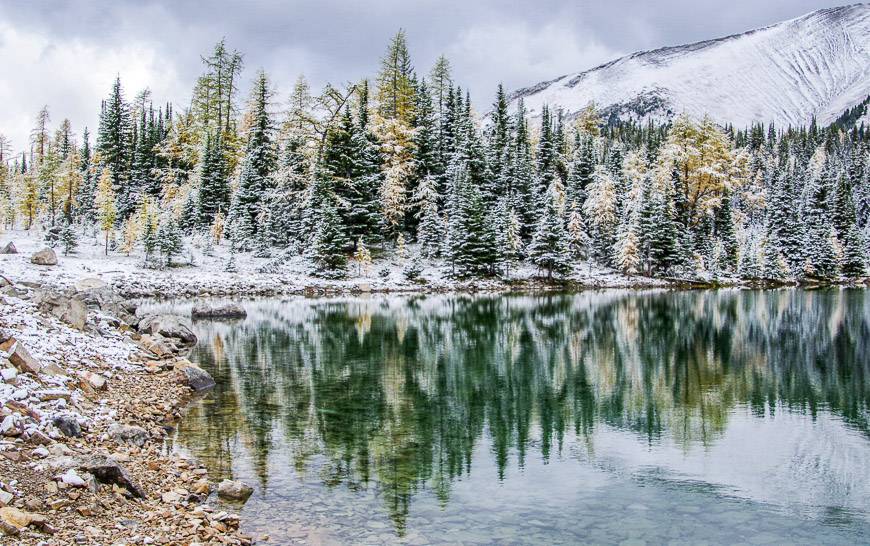
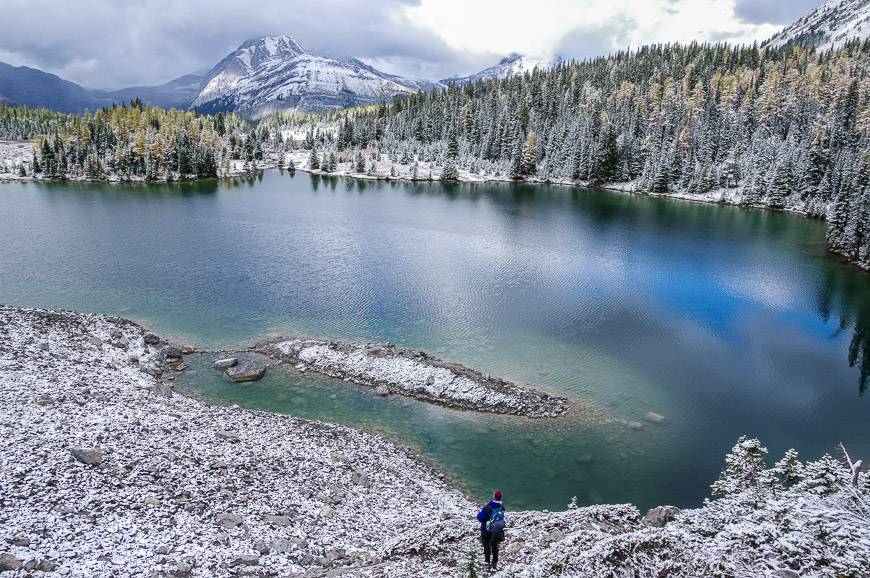
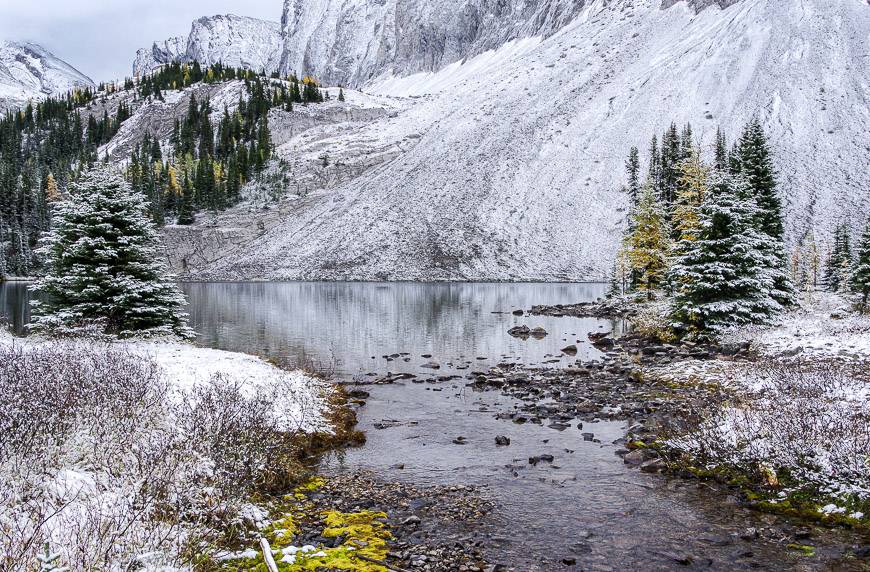
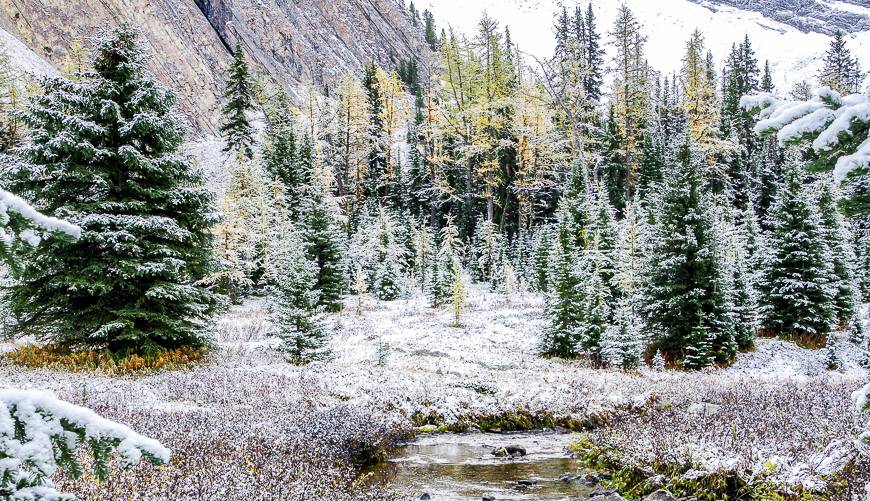
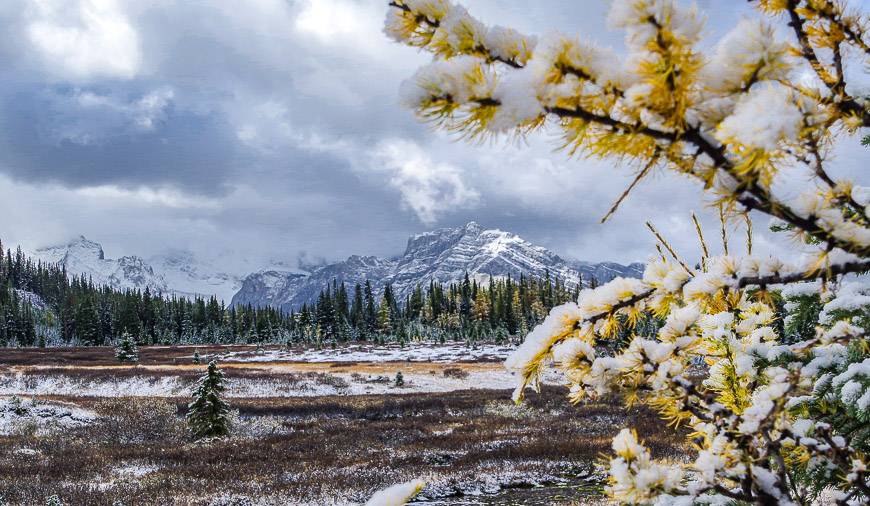
Arethusa Cirque – it’s becomes one of the most popular larch hikes in Alberta
Distance: 4.6 km return
Elevation gain: 250 m
Time needed: 2 – 3 hours
For a short, relatively easy outing from the Highwood Pass area, you would do well to choose Arethusa Cirque hike. While the hike isn’t marked, it’s easy to follow.
On the way up to Arethusa Cirque, pass a tarn and then head for treeline on a trail through talus slopes. Larches can be seen once you break through the first section of trees all the way through to Arethusa Cirque. I think this is one of the top larch hikes in Alberta, but it’s still not quite as well known.
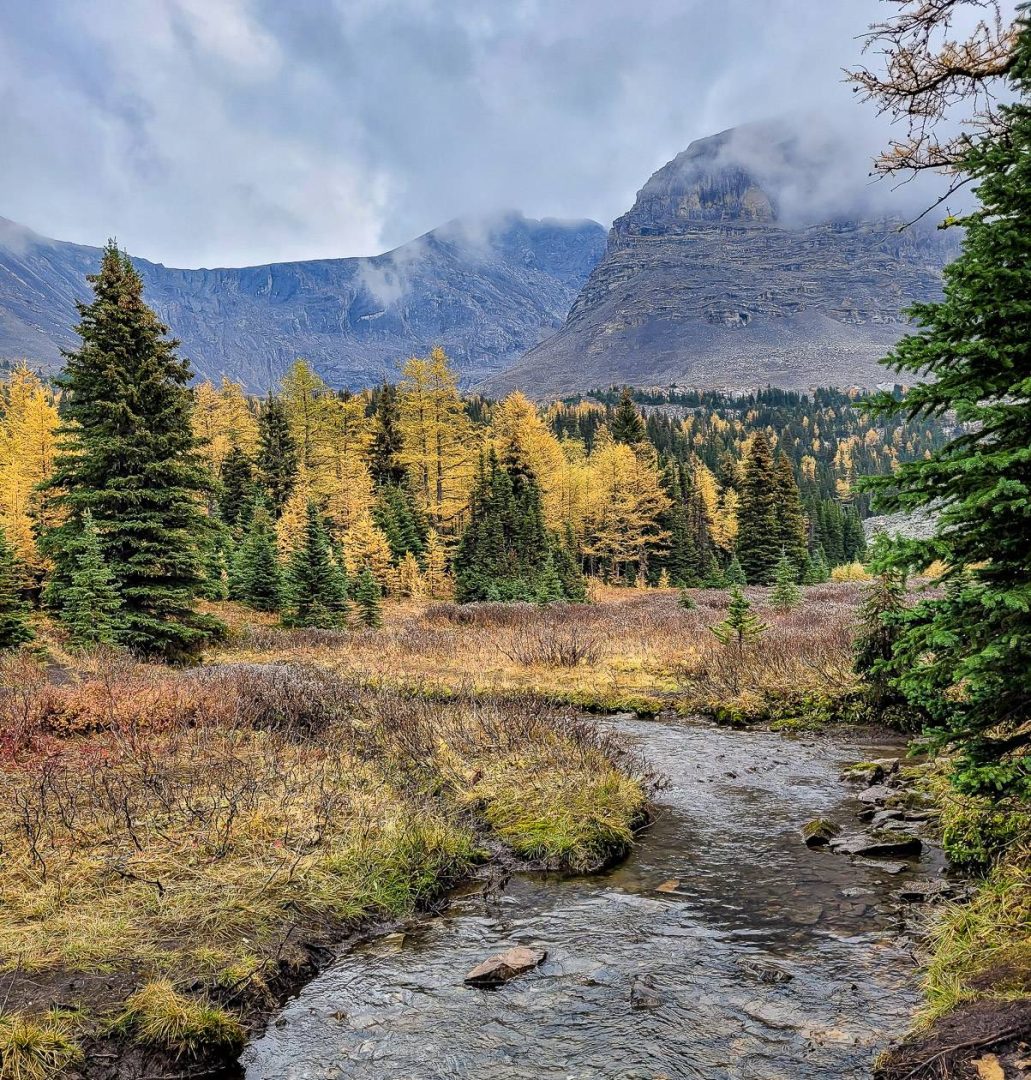
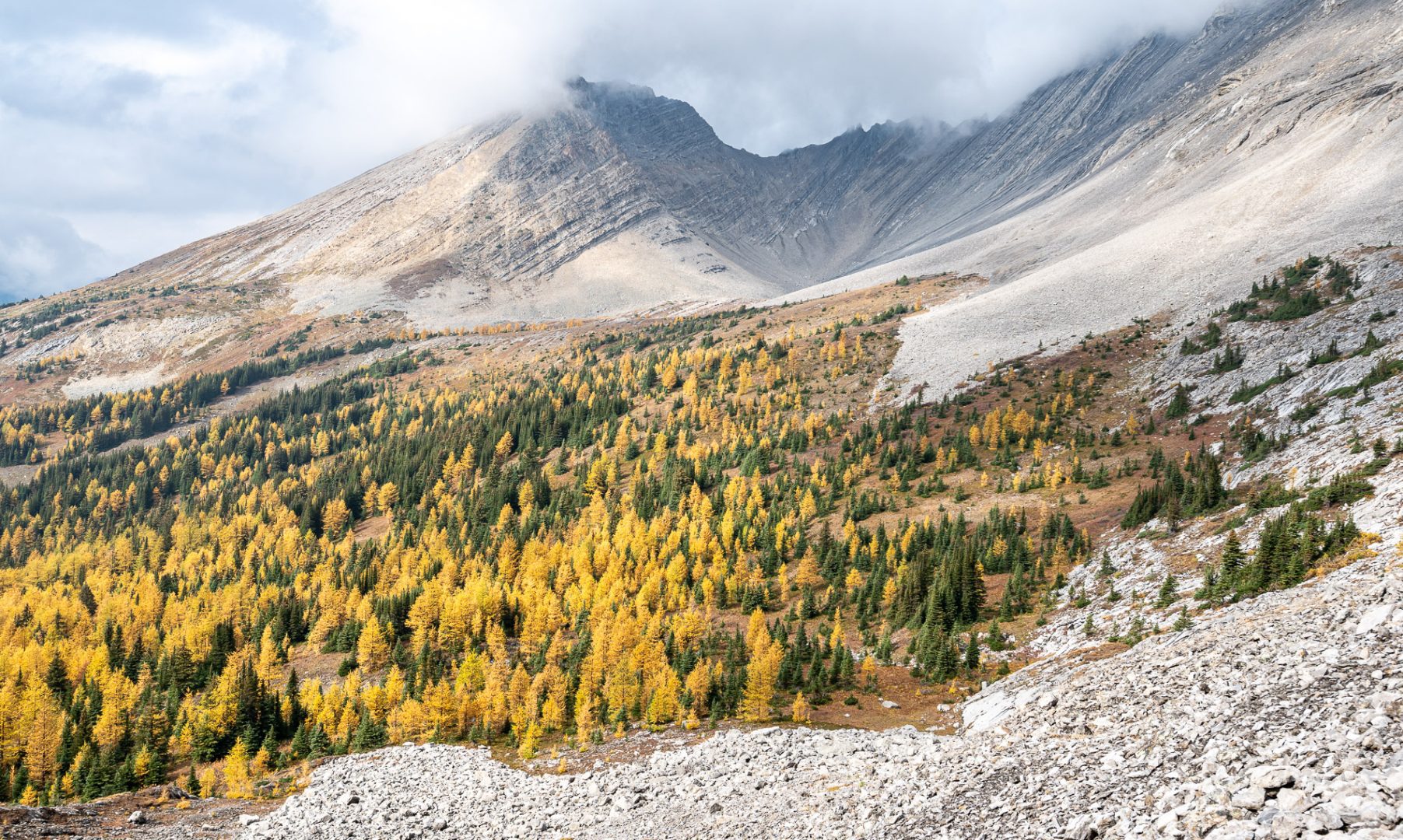
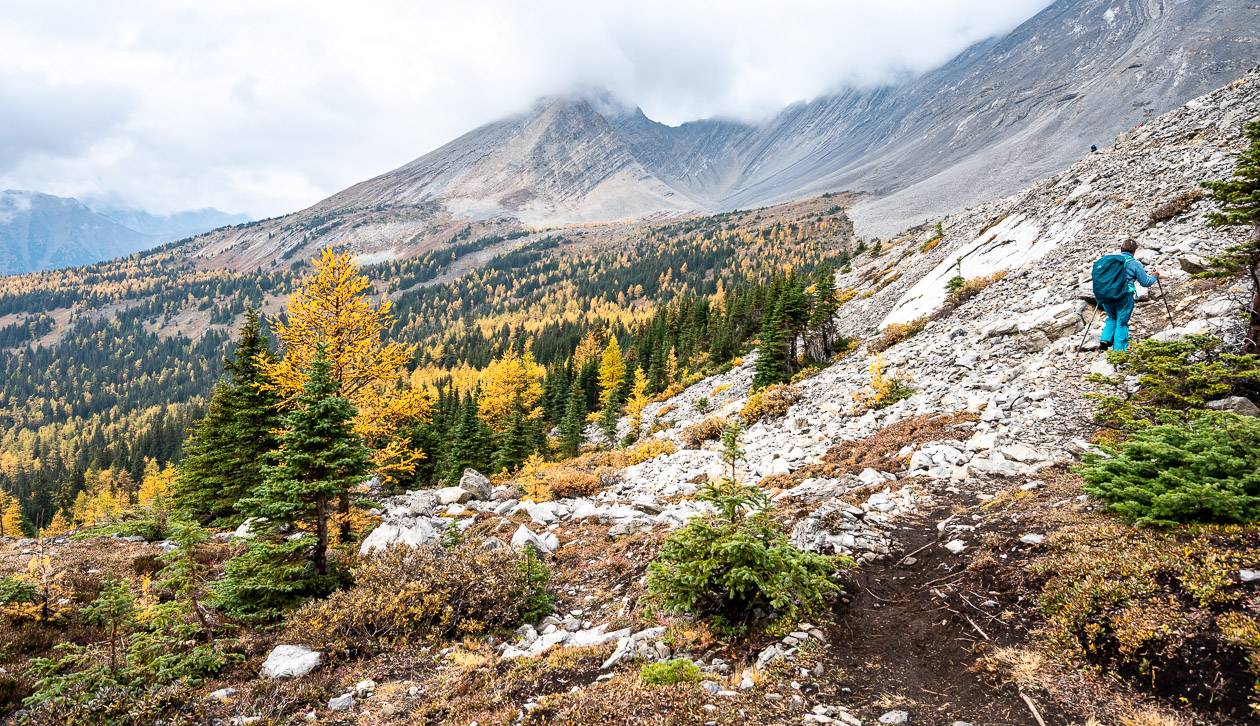
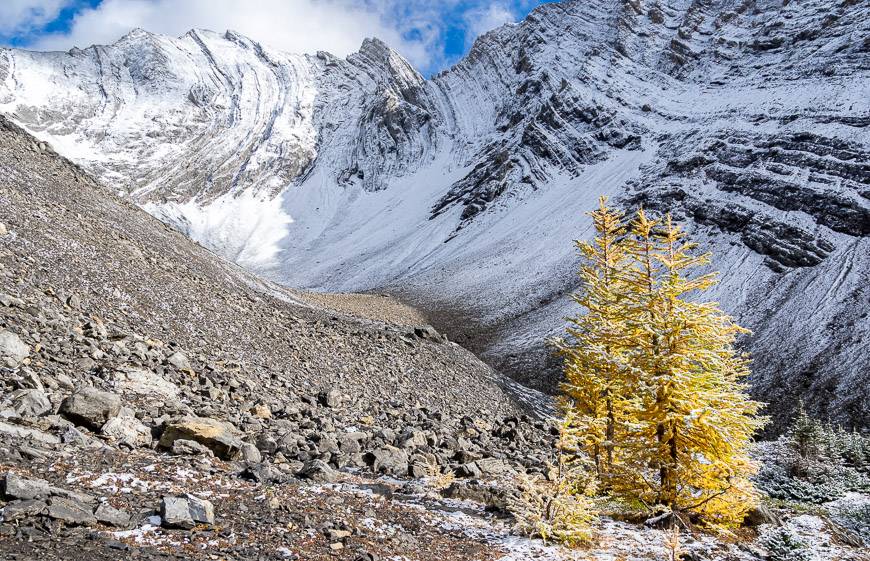
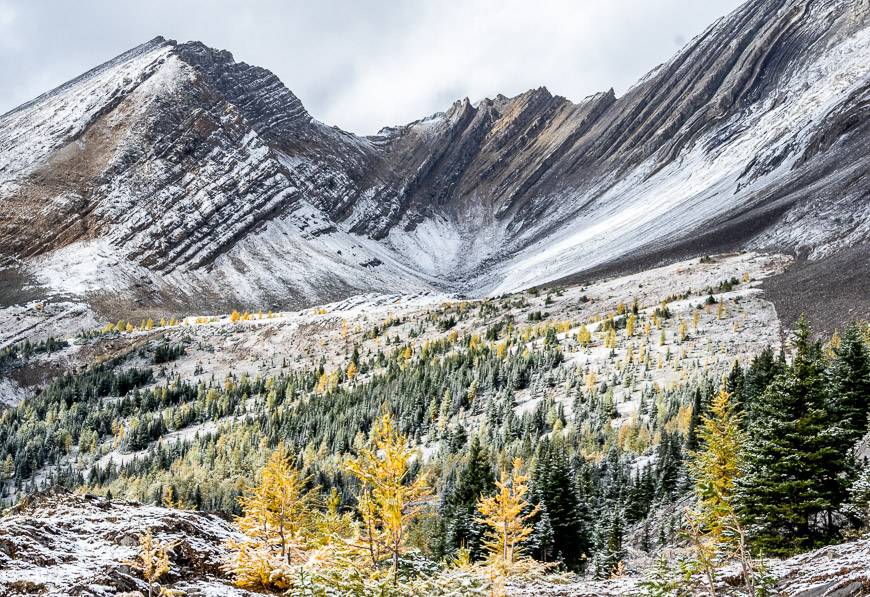
Buller Pass hike
Distance: 14.6 km round trip or 9.1 miles
Elevation gain: 670 m or 2,198 feet
Buller Pass is a beautiful hike that offers views of Ribbon Lake from the pass. On a weekday towards the end of larch season we were the only people on the trail. Reach the larches beginning about 45 minutes into the hike. They’ll be with you until you reach tree line and although they aren’t as impressive as some hikes, they do add a great blast of yellow to the landscape.
The trailhead is directly across from the Buller Mountain day use area, about 31 km from the Canmore Nordic Centre.
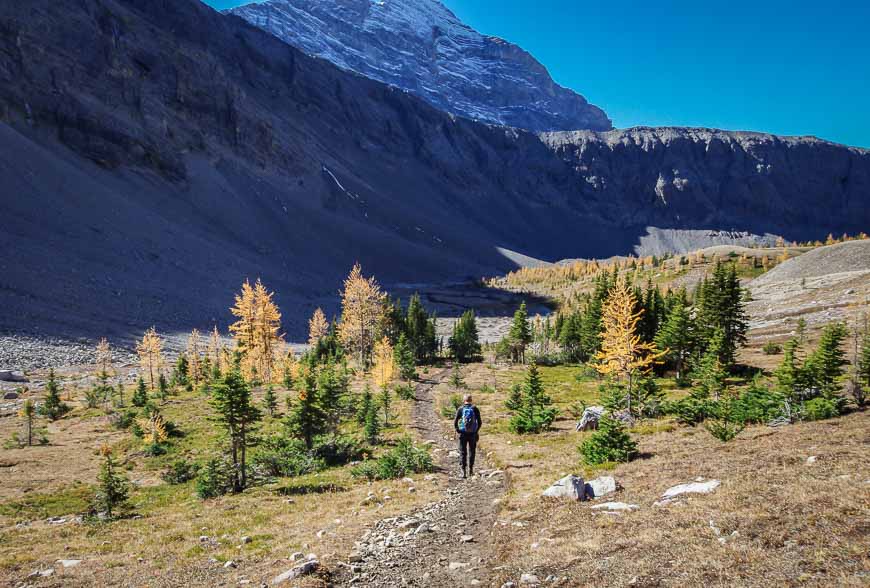
Larch hikes in Alberta in Waterton Lakes National Park
While I’ve never been to Waterton during larch season it only makes sense that it too would offer fantastic trails for larch viewing. In speaking with the Communications Officer from the park, John, the following suggestions were made. I would also recommend speaking to someone at the Visitor Centre so you can get he best, most up to date advice on your visit.
The hike to the Rowe Lakes (8 km round trip for the first lake, 13 km for the upper lake and 5 hours) is one of the best.
Less well-known for larches are a couple of trails that take off from the Blackiston Valley Trail. Start at the trailhead in the Red Rock Canyon parking area.
Bike or hike up part of the trail along Bauerman Creek. At the first intersection you can head for Goat Lake (13.6 km/5 hr from the Red Rock trailhead).
Alternatively continue to Twin Lakes, considered the best area for larches, especially around the Twin Lakes Campground. Both of these trails cut through bear country. Be prepared and don’t expect the larch displays to be as grand as they were before the 017 Kenow fire.
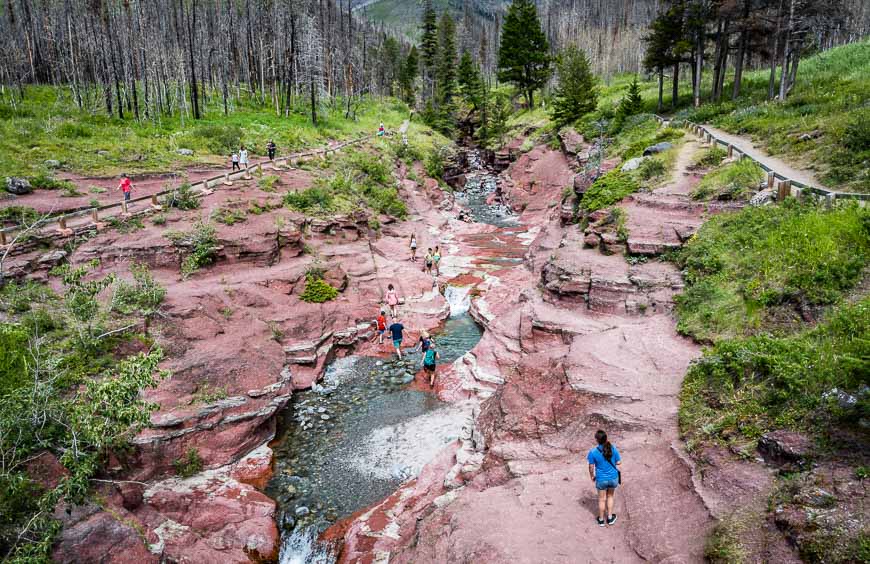
More ideas for larch hikes in Alberta – but I haven’t done them yet
In the bookPopular Day Hikes: The Castle and Crowsnestby Andrew Nugara, two hikes he describes sound amazing as larch hikes.
Consider Haig Ridge and Southfork Lakes in southern Alberta.
Another fantastic larch hike is the challenging Pasque Mountain hike off Highway 940. Outside of Alberta, head to Floe Lake in Kootenay National Park for a full day adventure and a gorgeous landscape.
Tips for viewing larches
Timing: Go VERY early in the day so you can get parking. Be patient.
Shuttles: If you’re heading to Lake Louise or Moraine Lake be sure to reserve Parks Canada shuttles in advance. There is also the option to take ROAM Transit from Canmore and Banff.
Bears: Fall is bear season, so go prepared. Carry easy to access bear spray that’s no more than two – three years old and make noise. Forget the bear bells. Voices are better. I would also suggest carrying bear spray in abear spray holsterso you don’t accidentally set it off.
Real time photos: Check out photos on Instagram using #larch and #larches as a hashtag. You’ll see when the colours are changing.
Guided hikes: If you would prefer a guided hike, check out what White Mountain adventures offers.
What to take: Carry an almost weightlessinflatable seat cushionso you can sit comfortably for an hour over lunch just enjoying the surreal beauty on one of the larch hikes in Alberta. Pack a lightweight down coat as the temperatures in the mountains can plummet quickly. I swear (really) by myPatagonia down sweater with a hood, a lightweightbuff, acozy toqueand a pair oflightweight gloves like thesethat my friend swears by.
Rain gear: Don’t forget the rain gear (theAquantator lineworks well with a good price point) and/or a windproof coat. If snow is in the forecast, remember to takegaiters.
Enjoy the mountains: Fall is my favourite season in Alberta. The beauty of the larch hikes in Alberta will keep you coming back year after year.
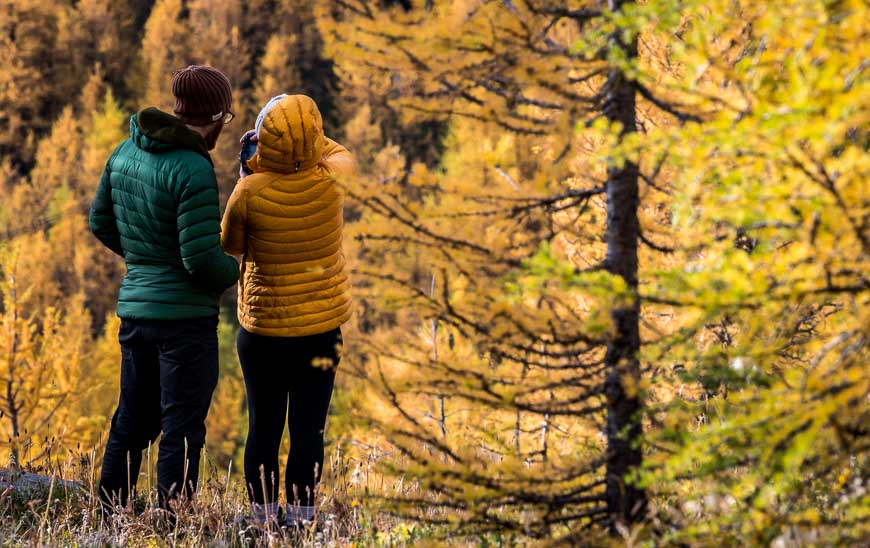
Click on the photo below to bookmark to your Pinterest boards.


